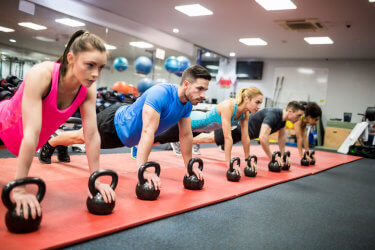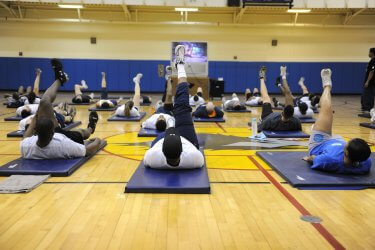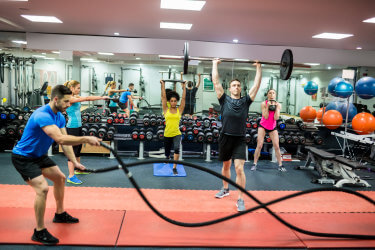This is the first of a three-part series on planning, developing and implementing a successful and productive off-season conditioning program for interscholastic sports programs. A previous article, “Principles and Axioms for Effective Coaching of Fitness and Conditioning” shared some basic principles of fitness training that you may want to look at as a prerequisite.
The purpose of this series of articles is to give coaches the specific tools to develop a sound, scientifically-based conditioning program that will encourage high participation and yield quality results. Each article in the series will focus on three essentials for a highly productive conditioning program. These three essentials are 1) Organization and Planning, 2) Efficiency, and 3) Effectiveness. After each article you will have specific tools that can be used to implement and measure each of the essentials. This first installment will be on the essential trait of Organization and Planning.
“The better your organization and planning, the greater will be your results.”
This essential trait refers to the up-front work and preparation a coach must do if he or she wants to make the conditioning program highly productive. The single most important measure of productivity you should be looking for is a high participation rate (all or almost all team members participating) throughout the off-season. “If they are knocking the door down to get into your conditioning program, then you are doing something right!” High participation will always be the ultimate measure of the success of your program. If you get high participation and your program is based upon sound, scientific principles, you will get the results you are expecting.
“Before you can get there, you have to know where you are going
. . . and you have to plan your work and work your plan.”
Do your Homework
First and foremost, know what you are doing! Try to find out all there is to know about conditioning. Research, read, and study the basic principles and concepts used in conditioning. The principles of overload, progression and specificity are basic concepts in any fitness program. You should also have knowledge of periodization and muscle confusion that are key concepts in conditioning. Look for colleagues who have successful conditioning programs and visit these programs in person. If you can’t get there yourself, use your phone and social media to communicate and find out what these successful programs are doing. Go to workshops and clinics on fitness, strength and conditioning whenever possible. Find out who the leading conditioning professionals are and research what they are doing by directly asking questions.
As an upfront precaution you must take into consideration the rapid physical changes teenagers will go through from ages 12-17. Girls’ changes typically happen earlier and slow down during their later teen years, while boys’ changes are slower in the early teens then very rapid through the age of 18. Remember that bone growth plates are still active and growing. Be especially slow and careful with “first-timers.” Young teens as first timers playing an interscholastic sport will be entering a sport-specific physical conditioning program for the very first time. Keep this factor in mind and start these “first-timers” gradually with emphasis on instruction, technique and safety. I would caution you against modeling your conditioning program and routines after college level programs that are designed for physically mature athletes experienced in year-round conditioning.

Safety! Safety! Safety!
Your planning should always have safety in mind. When using a strength training facility with free weights in a school setting know that it is the most dangerous room in the entire school building. Not only can free weights be dropped, they can also be lifted incorrectly resulting in serious injuries. You must demand correct technique on all exercises using free weights. The better the technique, the less the risk of injury. Post rules and protocols for use of the facility and equipment and ensure they are strictly followed.
Know where you are going!
Know your sport and the physical traits your athletes need to possess to learn the high-level sports skills needed to be successful. Specifically, if it is foot speed, what are the benchmark levels that are needed? (by position, grade level or group). If it is strength, what are the benchmark levels? If it is power? If it is cardiovascular and muscular endurance? If it is flexibility, balance, or agility? Before you know where you are going, you must know where you are. Of the above fitness items, be sure you know the current benchmark levels for your athletes.
For any off-season conditioning program to be successful, it must have a purpose that is measurable. To tell your students their goal is to get stronger, faster, and to build stamina is much too general. To initiate genuine purpose in your program, you should identify fitness items that match your sport and athlete needs and use fitness tests that measure these exact items to establish baseline levels. These pre-conditioning benchmarks answer the question “Where are you now?”
You then need to know enough about your sport to identify post-conditioning measures of the physical capabilities your athletes need to learn the necessary motor skills and become successful team members. These post-conditioning measures answer the question “Where are you going?” If you do this you will be in position to establish real purpose in your program, and because it is measurable, it is personal and saleable to your athletes. This topic will be discussed further in the future article on Effectiveness.
I recommend you select only a few test items to help focus your athletes’ efforts. Testing takes time, and depending on the number of participants, too many test items compromises efficiency and productivity. You might want to use a few items more often to simply to reinforce your goals and to give immediate feedback to your athletes: For example, one or two strength items (parallel squat, bench press), one or two power items (vertical jump, power clean) and one speed item. Flexibility (sit and reach, extended squat) and agility items (pro agility, shuttle run) do not need to be tested as often unless your athletes’ needs warrant more feedback.

Know how you are going to get there!
This is the “Plan your work“ part. Exactly what is it that you will have your athletes do for the entire off-season? How many days per week? How many participants will you have in each conditioning session? What workouts will you have planned for them? How will all of this be communicated to your athletes? If you have done your homework you should be prepared to determine the various workout programs you will have your athletes do during the entire off-season. Remember, your off-season will likely be about seven to eight months in length and should include all the workouts leading up to the first official practice. Here are three recommended steps to follow:
Step 1: Divide your off-season into segments or periods lasting anywhere from 3 weeks to 3 months. Determine the number of segments by the number of different workout you will use throughout the entire off-season.
Step 2: Determine the type of workouts you will use throughout the off-season. A minimum of three different workout schemes should be used to infuse variety (very important for teenagers!) and muscle confusion throughout the off-season. Example: Super-setting (4 weeks); Periodization (3 months), Heavy—light (2 months); CrossFit Training (7 weeks). Notice this division uses a variety of workout schemes/concepts, employing muscle confusion and avoiding boredom to set in during the long off-season. Remember, you are selecting your workout schemes based upon the needs of your athletes and what scientific research and best practices have developed. Additionally, you need to infuse these workouts with supplementary exercise routines—dynamic and static stretching, plyometrics, speed development drills, cardio workouts, core exercise routines, etc.—that address other fitness items that are not a part of the major workout schemes you have selected. I will address these more in the article on Efficiency.
Step 3: Make a handout putting all the facets of your off-season program on paper. You can make this handout electronic where it can be communicated to your athletes and even their parents. This handout should include the following:
- A title page. Make this an eye-catching page using high quality graphics and logos.
- A goals and objectives page. This should state the goals and objectives for your team. Since young teens are growing rapidly, I suggest you use grade levels to set objectives for your team. You may also want to use team positions as a grouping for goal setting.
- A “Why?” page. Give a summary explanation of the principles of overload, progression and specificity and the different kinds of conditioning schemes that will be used. This is the “Why we are doing this” page where you will sell your participants on the value of their commitment and participation. I will discuss this in greater detail in a future article on Effectiveness.
- A rewards page. Include all testing dates and the rewards for reaching improvement benchmarks.
- Workout overview pages. Include a summary of each workout to be used during each period/segment.
If you use the key words, “High school strength and conditioning programs,” in your search engine you will find numerous high school level conditioning programs online. I encourage you to examine these and use them when you develop your program’s overview handout.
You are now ready to begin! I will address the necessary steps for making your program more efficient and effective in two future articles.

